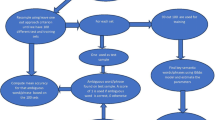Abstract
The resolution of ambiguities is one of the central problems for Machine Translation. In this paper we propose a knowledge-based approach to disambiguation which uses Description Logics (dl) as representation formalism. We present the process of anaphora resolution implemented in the Machine Translation systemfast and show how thedl systemback is used to support disambiguation.
The disambiguation strategy uses factors representing syntactic, semantic, and conceptual constraints with different weights to choose the most adequate antecedent candidate. We show how these factors can be declaratively represented as defaults inback. Disambiguation is then achieved by determining the interpretation that yields a qualitatively minimal number of exceptions to the defaults, and can thus be formalized as exception minimization.
Similar content being viewed by others
References
Bobrow, D.G., Collins, A.M. (eds.) (1975),Representation and Understanding: Studies in Cognitive Science, New York: Academic Press.
Bosch, P. (1988), ‘Representing and Accessing Focussed Referents’, inLanguage and Cognitive Processes 3, pp. 207–231.
Brachman, R.J. (1979), ‘On the Epistemological Status of Semantic Networks’, in N.V. Findler (ed.),Associative Networks: Representation and Use of Knowledge by Computers, New York: Academic Press, pp. 3–50.
Brachman, R.J. and Schmolze, J.G. (1985). ‘An Overview of thekl-one knowledge Representation System’,Cognitive Science 9, pp. 171–216.
Brachman, R.J., McGuiness, D.L. Patel-Schneider, P.F., Alperin Resnick, L. and Borgida, A. (1991), ‘Living with CLASSIC’, in J. Sowa (ed.),Principles of Semantic Networks: Explorations in the Representation of Knowledge, pp. 401–456.
Busemann, S. and Hauenschild, C. (1989), ‘Fromfas Representation to GPSG Structures’, in S. Busemann, C. Hauenschild, and C. Umbach (eds.),Views of the Syntax/Semantics Interface, KIT-Report 74, Technische Universität Berlin.
Carpenter, B. (1992),The Logic of Typed Feature Structures, Cambridge: Cambridge University Press.
Donini, F.M., Lenzerini, M. Nardi, D. and Nutt, W. (1991), ‘The Complexity of Concept Languages’,KR '91, pp. 151–162.
Engdahl, E. (1991), ‘Argument Roles and Anaphora’ in R.H. Cooper, K. Mukai and J. Perry (eds.),Situation Theory and its Applications I, Stanford: CSLI Lecture Notes 22, pp. 379–393.
Gazdar, G., Klein, E., Pullum, G. and Sag, I. (1985)Generalized Phrase Structure Grammar. Oxford: Basil Blackwell.
Grosz, B. and Sidner, C. (1986), ‘Attention, Intentions, And the Structure of Discourse’,Computational Linguistics,12, pp. 175–204.
Hauenschild, C. and Pause, P.E. (1983), ‘Faktoren-Analyse zur Modellierung des Textverstehens’,Linguistische Berichte 88, pp. 101–121.
Hauenschild, C. and Umbach, C. (1988), ‘Funktor-Argument-Struktur. Die satzsemantische Repräsentations-und Transferebene im Projektkit-fast’, in J. Schütz (ed.),Workshop Semantik und Transfer, EUROTRA-D Working Papers 6, Saarbrücken, pp. 16–35.
Hayes, P.J. (1977), ‘In Defense of Logic’,IJCAI' 77, pp. 559–565.
Hobbs, J.H. (1978), ‘Resolving Pronoun References’,Lingua,44, 311–338.
Hoppe, T., Kindermann, C., Quantz, J.J., Schmiedel, A. and Fischer, M. (1993)back v5Tutorial & Manual, KIT Report 100, Technische Universität Berlin.
Jackendoff, R. (1983),Semantics and Cognition. MIT Press, Cambridge.
Kay, M., Gawron, J.M. and Norvig, P. (1991), ‘Verbmobil: A Translation System for Face-to-Face Dialog.
LuperFoy, S. and Rich, E. (1990),A Computational Model for the Resolution of Context Dependent References, MCC Technical Report, Austin.
MacGregor, R. (1991), ‘Using a Description Classifier to Enhance Deductive Inference’, inProceedings Seventh IEEE Conference on AI Applications, Miami, Florida, February, pp. 141–147.
Minsky, M. (1975), ‘A Framework for Representing Knowledge’, in P.H. Winston (ed.),The Psychology of Computer Vision, New York: McGraw-Hill, pp. 211–277.
Pollard, C. and Sag, I.A. (1987),An Information Based Syntax and Semantics, Vol. I. Fundamentals, Stanford: CSLI Lecture Notes 13.
Pollard, C. and Sag, I.A. (1993),Head-Driven Phrase Structure Grammar, University of Chicago Press.
Preuβ, S., Schmitz, B., Hauenschild, C. and Umbach, C. (1992), ‘Anaphora Resolution in Machine Translation’. KIT Report 104, Technische Universität Berlin.
Quantz, J.J. (1990)Modeling and Reasoning with Defined Roles, KIT Report 84, Technische Universität Berlin, 1990.
Quantz, J.J. (1992a),Semantische Repräsentation anaphorischer Bezüge in terminologischen Logiken, KIT Report 96, Technische Universität Berlin.
Quantz, J.J. (1992b), ‘How to Fit Generalized Quantifiers into Terminological Logics’,ECAI-92, pp. 543–547.
Quantz, J.J. (1993),Interpretation as Exception Minimization, IJCAI'93.
Quantz, J.J. and Royer, V. (1992). ‘A Preference Semantics for Defaults in Terminological Logics’, in B. Nebel, C. Rich, W. Swartout (eds.),Principles of Knowledge Representation and Reasoning: Proceedings of the Third International Conference, San Mateo: Morgan Kaufmann, pp. 294–305.
Quillian, M.R. (1968). ‘Semantic Memory’, in M. Minsky (ed.),Semantic Information Processing, Cambridge (Mass): MIT Press, pp. 216–270.
Reinhart, T. (1983), ‘Coreference and Bound Anaphora: A Restatement of The Anaphora Questions,Linguistics and Philosophy 6, pp. 47–88.
Royer, V. and Quantz, J.J. (1992), ‘Deriving Inference Rules for Terminological Logics’, in D. Pearce and G. Wagner (eds.),Logics in Al, Proceedings of JELIA '92, Berlin: Springer, pp. 84–105.
Schmitz, B. and Quantz, J.J. (1993), ‘Defaults in Machine Translation’, KIT Report 106, Technische Universität Berlin.
Sgall, P., Hajičovà, E. and Benešovà, E. (1973),Topic, Focus and Generative Semantics, Kronberg: Scriptor.
Steiner, E., Schmidt, P. and Zelinsky-Wibbelt, C. (1988),From Syntax to Semantics: Insights from Machine Translation. London: Pinter.
Woods, W.A. (1975), ‘What's in A Link: Foundations for Semantic Networks’, in D.G. Bobrow and A.M. Collins (eds.),Representation and Understanding: Studies in Cognitive Science, New York: Academic Press, pp. 35–82.
Zelinsky-Wibbelt, C. (1988), ‘From Cognitive Grammar to the Generation of Semantic Interpretation in Machine Translation’, in Steineret al., pp. 105–132.
Author information
Authors and Affiliations
Rights and permissions
About this article
Cite this article
Quantz, J., Schmitz, B. Knowledge-based disambiguation for machine translation. Mind Mach 4, 39–57 (1994). https://doi.org/10.1007/BF00974203
Issue Date:
DOI: https://doi.org/10.1007/BF00974203




